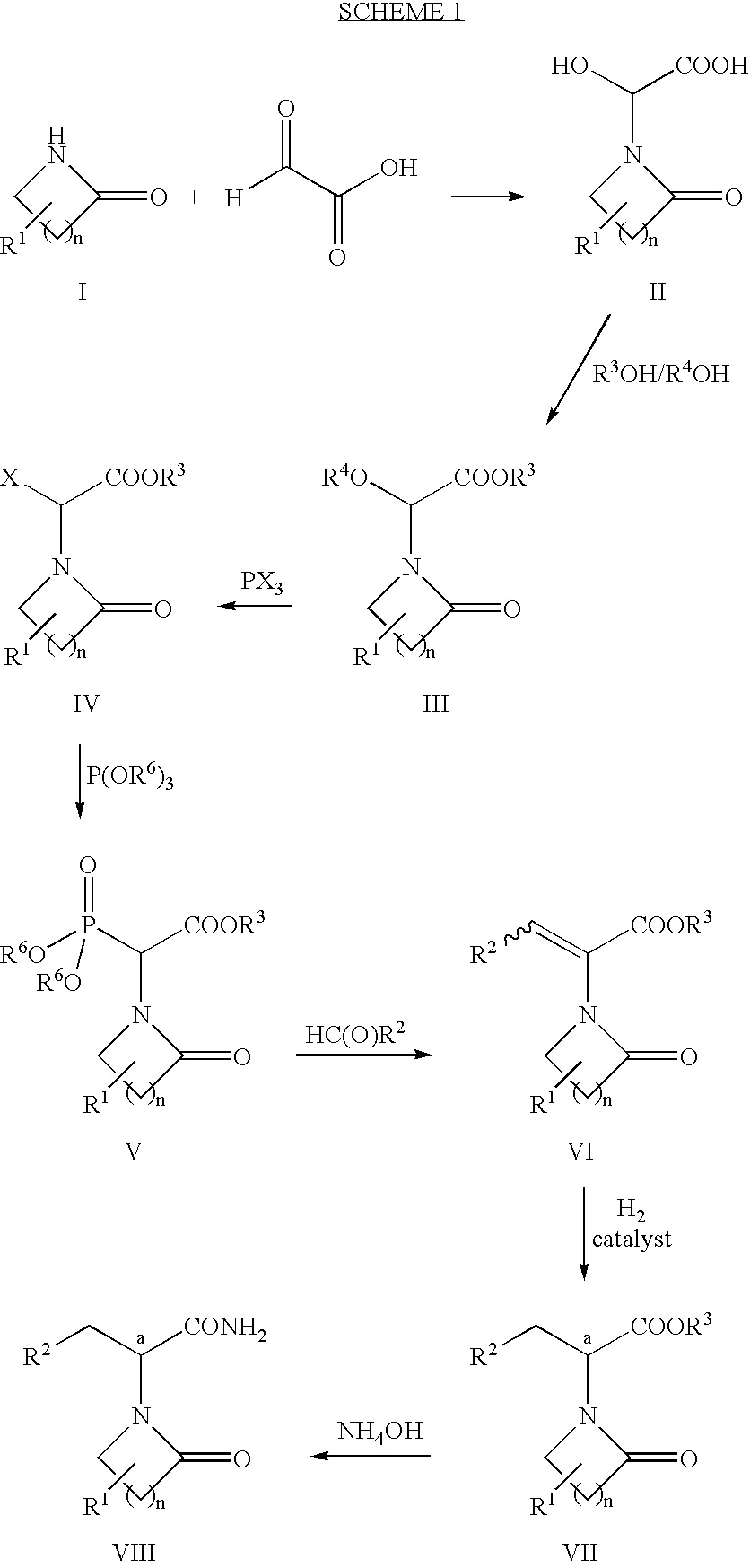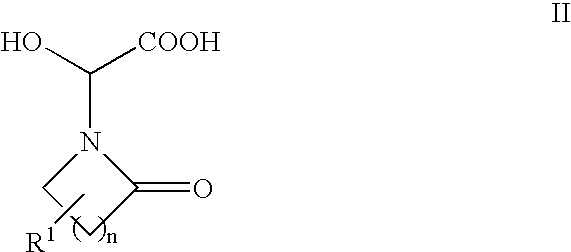Highly enantiomerically pure lactam-substituted propanoic acid derivatives and methods of making and using same
a technology of lactam-substituted propanoic acid and high enantiomer, which is applied in the direction of physical/chemical process catalysts, bulk chemical production, organic compound/hydride/coordination complex catalysts, etc., can solve the problem of unclear viability of the standard preparative sequence for enamide and unclear effect of asymmetric catalysts for the hydrogenation of lactam-substituted 2-propenoic acid derivatives
- Summary
- Abstract
- Description
- Claims
- Application Information
AI Technical Summary
Benefits of technology
Problems solved by technology
Method used
Image
Examples
example 1
Preparation of Methyl 2-(2-Pyrrolidino)Propanoate
Step 1: Preparation of Hydroxy-Acid 2a (Formula II, n=2, R1═R3═R4═H):
[0066]Glyoxylic acid monohydrate (20.2 g; 220 mmol; 1.1 equiv) was slurried in 200 mL of diethyl ether. Pyrrolidinone (15.2 mL; 200 mmol) was added and the resulting mixture was stirred at ambient temperature for two days to afford a white precipitate. The precipitate was isolated by filtration, washed with ether, and air-dried to afford 36.06 g (99%) of hydroxy-acid 2a.
[0067]1H NMR (DMSO-d6) δ 5.55 (s, 1 H); 3.5-3.3 (m, 2H); 3.36 (s, 3H); 2.46 (m, 2H); 2.07 (m, 2H).
Step 2: Preparation of Ether-Ester 3a (Formula III n=2, R1═H, R3═R4=Me):
[0068]Hydroxy-acid 2a (25.3 g; 160 mmol) was dissolved in methanol (370 mL), cooled in ice-water, and treated with concentrated sulfuric acid (5.0 mL; 0.093 mmol; 0.57 molar equiv). The reaction mixture was allowed to warm to ambient temperature and allowed to stir for 5 days. Solid sodium bicarbonate (17.1 g; 203 mmol; 1.27 equiv) wa...
example 2
In Situ Preparation of Compound VI (n=2, R1═H, R2═R3=Me):
[0077]Ether-ester 3a (9.36 g; 50 mmol) was dissolved in 25 mL of toluene. The reaction mixture was heated to 50° C. and phosphorus trichloride (4.4 mL; 50 mmol; 1.0 equiv) was added and the mixture was held at 50° C. for 16 h. The reaction mixture was cooled to ambient temperature and sodium bicarbonate (10.5 g; 125 mmol; 2.5 equiv) was added. The mixture was stirred for 15 min, filtered, and the volatiles were stripped. The solution was reconstituted by the addition of toluene (25 mL) and heated to 70° C. Trimethyl phosphite (6.5 mL; 55 mmol; 1.1 equiv) was added and the reaction mixture was heated at 70° C. for 24 h to completely consume 4a. The mixture was then cooled to 2° C. and acetaldehyde (4.2 mL; 75 mmol; 1.5 equiv) was added. Tetramethylguanidine (9.41 mL; 75 mmol; 1.5 equiv) was then added slowly dropwise with an attendant exotherm to 8.5° C. The reaction mixture was allowed to warm to ambient temperature and stirre...
example 3
Preparation of Ethyl 2-(2-Pyrrolidino)Propanoate
Step, 2: Preparation of Ether-Ester 3b (Formula III, n=2, R1═H, R3═R4=Et):
[0078]Hydroxy-acid 2a (7.96 g; 50 mmol) was dissolved in ethanol (25 mL), and triethyl orthoformate (18.3 mL; 110 mmol; 2.2 equiv) was added. p-Toluenesulfonic acid (0.48 g; 2.5 mmol; 0.05 equiv) was added and the reaction mixture was heated to 60° C. for 24 h. Solid sodium bicarbonate (0.50 g; 6 mmol; 0.12 equiv) was added and the reaction mixture was stirred for 15 min. The volatiles were evaporated at reduced pressure and the remaining material was dissolved in 1:1 toluene:ethyl acetate (25 mL), filtered, and concentrated to afford 10.25 g (95%) of 3b.
[0079]1H NMR (CDCl3) δ 5.72 (s, 1 H); 4.24 (q, 2H, J=7.14 Hz); 3.57 (q, 2H, J=6.87 Hz); 3.5-3.3 (m, 2H); 2.47 (t, 2H, J=7.42 Hz); 2.06 (m(5), 2H, J=7.42 Hz); 1.29 (t, 3H, J=7.14 Hz); 1.25 (t, 3H, J=6.87 Hz).
Steps 3 and 4: Preparation of Phosphonate Ester 5b (Formula V, n=2, R1═H, R3=Et R6=Me):
[0080]Ether-ester 3b...
PUM
| Property | Measurement | Unit |
|---|---|---|
| temperature | aaaaa | aaaaa |
| temperature | aaaaa | aaaaa |
| temperature | aaaaa | aaaaa |
Abstract
Description
Claims
Application Information
 Login to View More
Login to View More - R&D
- Intellectual Property
- Life Sciences
- Materials
- Tech Scout
- Unparalleled Data Quality
- Higher Quality Content
- 60% Fewer Hallucinations
Browse by: Latest US Patents, China's latest patents, Technical Efficacy Thesaurus, Application Domain, Technology Topic, Popular Technical Reports.
© 2025 PatSnap. All rights reserved.Legal|Privacy policy|Modern Slavery Act Transparency Statement|Sitemap|About US| Contact US: help@patsnap.com



